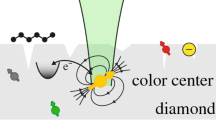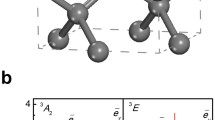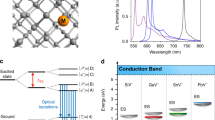Abstract
In the development of quantum computing and communications, improvements in materials capable of single photon emission are of great importance. Advances in single photon emission have been achieved experimentally by introducing nitrogen-vacancy (N-V) centers on diamond nanostructures. However, theoretical modeling of the anisotropic effects on the electronic properties of these materials is almost nonexistent. In this study, the electronic band structure and density of states of diamond nanowires with N-V defects were analyzed through first principles approach using the density functional theory and the supercell scheme. The nanowires were modeled on two growth directions [001] and [111]. All surface dangling bonds were passivated with hydrogen (H) atoms. The results show that the N-V introduces multiple trap states within the energy band gap of the diamond nanowire. The energy difference between these states is influenced by the growth direction of the nanowires, which could contribute to the emission of photons with different wavelengths. The presence of these trap states could reduce the recombination rate between the conduction and the valence band, thus favoring the single photon emission.

Diamond nanowires with nitrogen-vacancy centerᅟ






Similar content being viewed by others
References
Broadbent A, Schaffner C (2016) Quantum cryptography beyond quantum key distribution. Des Codes Cryptogr 78(1):351–382. https://doi.org/10.1007/s10623-015-0157-4
Trabesinger A (2017) Quantum computing: towards reality. Nature 543(7646):S1–S1. https://doi.org/10.1038/543S1a
Lupo C, Pirandola S (2016) Ultimate precision bound of quantum and subwavelength imaging. Phys Rev Lett 117(19):190802. https://doi.org/10.1103/PhysRevLett.117.190802
Lounis B, Moerner W (2000) Single photons on demand from a single molecule at room temperature. Nature 407(6803):491–493. https://doi.org/10.1038/35035032
Moreau E, Robert I, Gérard J, Abram I, Manin L, Thierry-Mieg V (2001) Single-mode solid-state single photon source based on isolated quantum dots in pillar microcavities. Appl Phys Lett 79(18):2865–2867. https://doi.org/10.1063/1.1415346
Ma X, Hartmann NF, Baldwin JK, Doorn SK, Htoon H (2015) Room-temperature single-photon generation from solitary dopants of carbon nanotubes. Nat Nanotechnol 10(8):671–675. https://doi.org/10.1038/nnano.2015.136
Wrachtrup J (2016) 2D Materials: single photons at room temperature. Nat Nanotechnol 11(1):7–8. https://doi.org/10.1038/nnano.2015.265
Castelletto S, Johnson B, Ivády V, Stavrias N, Umeda T, Gali A, Ohshima T (2014) A silicon carbide room-temperature single-photon source. Nat Mater 13(2):151–156. https://doi.org/10.1038/nmat3806
Koperski M, Nogajewski K, Arora A, Cherkez V, Mallet P, Veuillen J-Y, Marcus J, Kossacki P, Potemski M (2015) Single photon emitters in exfoliated WSe2 structures. Nat Nanotechnol 10(6):503–506. https://doi.org/10.1038/nnano.2015.67
Englund D, Fattal D, Waks E, Solomon G, Zhang B, Nakaoka T, Arakawa Y, Yamamoto Y, Vučković J (2005) Controlling the spontaneous emission rate of single quantum dots in a two-dimensional photonic crystal. Phys Rev Lett 95(1):013904. https://doi.org/10.1103/PhysRevLett.95.013904
Högele A, Galland C, Winger M, Imamoğlu A (2008) Photon Antibunching in the photoluminescence spectra of a single carbon nanotube. Phys Rev Lett 100(21):217401. https://doi.org/10.1103/PhysRevLett.100.217401
Kurtsiefer C, Mayer S, Zarda P, Weinfurter H (2000) Stable solid-state source of single photons. Phys Rev Lett 85(2):290–293. https://doi.org/10.1103/PhysRevLett.85.290
Rodiek B, Lopez M, Hofer H, Porrovecchio G, Smid M, Chu X-L, Gotzinger S, Sandoghdar V, Lindner S, Becher C, Kuck S (2017) Experimental realization of an absolute single-photon source based on a single nitrogen vacancy center in a nanodiamond. Optica 4(1):71–76. https://doi.org/10.1364/OPTICA.4.000071
Doherty MW, Manson NB, Delaney P, Jelezko F, Wrachtrup J, Hollenberg LCL (2013) The nitrogen-vacancy colour centre in diamond. Phys Rep 528(1):1–45. https://doi.org/10.1016/j.physrep.2013.02.001
Sipahigil A, Goldman ML, Togan E, Chu Y, Markham M, Twitchen DJ, Zibrov AS, Kubanek A, Lukin MD (2012) Quantum interference of single photons from remote nitrogen-vacancy centers in diamond. Phys Rev Lett 108(14):143601. https://doi.org/10.1103/PhysRevLett.108.143601
Yang N, Uetsuka H, Osawa E, Nebel CE (2008) Vertically aligned diamond nanowires for DNA sensing. Angew Chem Int Ed 47(28):5183–5185. https://doi.org/10.1002/anie.200801706
Shalini J, Sankaran KJ, Dong C-L, Lee C-Y, Tai N-H, Lin IN (2013) In situ detection of dopamine using nitrogen incorporated diamond nanowire electrode. Nano 5(3):1159–1167. https://doi.org/10.1039/C2NR32939E
Liao M, Hishita S, Watanabe E, Koizumi S, Koide Y (2010) Suspended single-crystal diamond nanowires for high-performance nanoelectromechanical switches. Adv Mater 22(47):5393–5397. https://doi.org/10.1002/adma.201003074
Aharonovich I, Castelletto S, Simpson DA, Stacey A, McCallum J, Greentree AD, Prawer S (2009) Two-level Ultrabright single photon emission from diamond nanocrystals. Nano Lett 9(9):3191–3195. https://doi.org/10.1021/nl9014167
Babinec TM, Hausmann BJ, Khan M, Zhang Y, Maze JR, Hemmer PR, Lončar M (2010) A diamond nanowire single-photon source. Nat Nanotechnol 5(3):195–199. https://doi.org/10.1038/nnano.2010.6
Evans RE, Sipahigil A, Sukachev DD, Zibrov AS, Lukin MD (2016) Narrow-linewidth homogeneous optical emitters in diamond nanostructures via silicon ion implantation. Phys Rev Appl 5(4):044010. https://doi.org/10.1103/PhysRevApplied.5.044010
Momenzadeh SA, Stöhr RJ, de Oliveira FF, Brunner A, Denisenko A, Yang S, Reinhard F, Jr W (2014) Nanoengineered diamond waveguide as a robust bright platform for Nanomagnetometry using shallow nitrogen vacancy centers. Nano Lett 15(1):165–169. https://doi.org/10.1021/nl503326t
Yu Y, Wu L, Zhi J (2015) Diamond nanowires: fabrication, structure, properties and applications.Novel aspects of diamond. Springer, Berlin, pp 123–164. https://doi.org/10.1007/978-3-319-09834-0_5
Gali A, Maze JR (2013) Ab initio study of the split silicon-vacancy defect in diamond: electronic structure and related properties. Phys Rev B 88(23):235205. https://doi.org/10.1103/PhysRevB.77.155206
Gali A, Fyta M, Kaxiras E (2008) Ab initio supercell calculations on nitrogen-vacancy center in diamond: electronic structure and hyperfine tensors. Phys Rev B Condens Matter 77(15):155206. https://doi.org/10.1103/PhysRevB.77.155206
Larsson J, Delaney P (2008) Electronic structure of the nitrogen-vacancy center in diamond from first-principles theory. Phys Rev B Condens Matter 77(16):165201. https://doi.org/10.1103/PhysRevB.77.165201
Goss J, Briddon P (2006) Theory of boron aggregates in diamond: first-principles calculations. Phys Rev B 73(8):085204. https://doi.org/10.1103/PhysRevB.73.085204
Niu L, Zhu J-Q, Han X, Tan M-L, Gao W, Du S-Y (2009) First principles study of structural, electronic and vibrational properties of heavily boron-doped diamond. Phys Lett A 373(29):2494–2500. https://doi.org/10.1016/j.physleta.2009.05.008
D’Haenens-Johansson U, Edmonds A, Green B, Newton M, Davies G, Martineau P, Khan R, Twitchen D (2011) Optical properties of the neutral silicon split-vacancy center in diamond. Phys Rev B 84(24):245208. https://doi.org/10.1103/PhysRevB.84.245208
Abdulsattar MA (2015) Electronic and structural properties of nitrogen-vacancy center in diamond nanocrystals: a theoretical study. Karbala Int J Modern Sci 1(3):142–151. https://doi.org/10.1016/j.kijoms.2015.10.008
Parlinski K, Li Z, Kawazoe Y (1997) First-principles determination of the soft mode in cubic ZrO2. Phys Rev Lett 78(21):4063. https://doi.org/10.1103/PhysRevLett.78.4063
Yang H, Tang Y, Gong J, Liu Y, Wang X, Zhao Y, Yang P, Wang S (2013) Influence of doped nitrogen and vacancy defects on the thermal conductivity of graphene nanoribbons. J Mol Model 19(11):4781–4788. https://doi.org/10.1007/s00894-013-1937-2
Barnard A, Russo S, Snook I (2003) Ab initio modelling of boron and nitrogen in diamond nanowires. Philos. Mag. 83(19):2301–2309
Barnard AS, Russo SP, Snook IK (2003) Ab initio modeling of diamond nanowire structures. Nano Lett 3(10):1323–1328. https://doi.org/10.1021/nl034169x
Zhang J, Cao J, Chen X, Ding J, Zhang P, Ren W (2015) Diamond nanowires with nitrogen vacancy under a transverse electric field. Phys Rev B Condens Matter 91(4):045417. https://doi.org/10.1103/PhysRevB.91.045417
Trejo A, Miranda A, Toscano-Medina L, Vázquez-Medina R, Cruz-Irisson M (2016) Optical vibrational modes of Ge nanowires: a computational approach. Microelectron Eng 159:215–220. https://doi.org/10.1016/j.mee.2016.04.024
Trejo A, Ojeda M, Cuevas JL, Ál M, Pérez LA, Cruz-Irisson M (2015) Electronic structure and optical vibrational modes of 3C–SiC nanowires. Int J Nanotechonol 12(3-4):275–284. https://doi.org/10.1504/IJNT.2015.067212
Ando Y, Nishibayashi Y, Sawabe A (2004) ‘Nano-rods’ of single crystalline diamond. Diam Relat Mater 13(4):633–637. https://doi.org/10.1016/j.diamond.2003.10.066
Rivas JG, Muskens OL, Borgström MT, Diedenhofen SL, Bakkers EP (2008) Optical anisotropy of semiconductor nanowires. In: Wang Z (ed) One-dimensional nanostructures. Lecture notes in nanoscale science and technology, vol 3. Springer, New York, pp 127–145. https://doi.org/10.1007/978-0-387-74132-1_6
Yu Y, Cui F, Sun J, Yang P (2016) Atomic structure of ultrathin gold nanowires. Nano Lett 16(5):3078–3084. https://doi.org/10.1021/acs.nanolett.6b00233
Zhu G, Zhang S, Xu Z, Ma J, Shen X (2011) Ultrathin ZnS single crystal nanowires: controlled synthesis and room-temperature ferromagnetism properties. J Am Chem Soc 133(39):15605–15612. https://doi.org/10.1021/ja2049258
Girard H, Arnault J, Perruchas S, Saada S, Gacoin T, Boilot J-P, Bergonzo P (2010) Hydrogenation of nanodiamonds using MPCVD: a new route toward organic functionalization. Diam Relat Mater 19(7):1117–1123. https://doi.org/10.1016/j.diamond.2010.03.019
Sque S, Jones R, Briddon P (2006) Structure, electronics, and interaction of hydrogen and oxygen on diamond surfaces. Phys Rev B Condens Matter 73(8):085313. https://doi.org/10.1103/PhysRevB.73.085313
Clark SJ, Segall MD, Pickard CJ, Hasnip PJ, Probert MI, Refson K, Payne MC (2005) First principles methods using CASTEP. Z Kristallogr 220(5/6):567–570. https://doi.org/10.1524/zkri.220.5.567.65075
Perdew JP, Burke K, Ernzerhof M (1996) Generalized gradient approximation made simple. Phys Rev Lett 77(18):3865. https://doi.org/10.1103/PhysRevLett.77.3865
Rappe AM, Rabe KM, Kaxiras E, Joannopoulos J (1990) Optimized pseudopotentials. Phys Rev B 41(2):1227. https://doi.org/10.1103/PhysRevB.41.1227
Hamann DR, Schlüter M, Chiang C (1979) Norm-conserving pseudopotentials. Phys Rev Lett 43(20):1494–1497. https://doi.org/10.1103/PhysRevLett.43.1494
Monkhorst HJ, Pack JD (1976) Special points for Brillouin-zone integrations. Phys Rev B Condens Matter 13(12):5188. https://doi.org/10.1103/PhysRevB.13.5188
Pfrommer BG, Côté M, Louie SG, Cohen ML (1997) Relaxation of crystals with the quasi-Newton method. J Comput Phys 131(1):233–240. https://doi.org/10.1006/jcph.1996.5612
Bruno M, Palummo M, Marini A, Del Sole R, Olevano V, Kholod AN, Ossicini S (2005) Excitons in germanium nanowires: quantum confinement, orientation, and anisotropy effects within a first-principles approach. Phys Rev B Condens Matter 72(15):153310. https://doi.org/10.1103/PhysRevB.72.153310
Perdew JP (1985) Density functional theory and the band gap problem. Int J Quantum Chem 28(S19):497–523. https://doi.org/10.1002/qua.560280846
Hasnip PJ, Refson K, Probert MIJ, Yates JR, Clark SJ, Pickard CJ (2014) Density functional theory in the solid state. Philos T Roy Soc A 372(2011). https://doi.org/10.1098/rsta.2013.0270
Hedin L (1965) New method for calculating the one-particle Green’s function with application to the electron-gas problem. Phys Rev 139(3A):A796. https://doi.org/10.1103/PhysRev.139.A796
Doherty MW, Manson NB, Delaney P, Hollenberg LCL (2011) The negatively charged nitrogen-vacancy centre in diamond: the electronic solution. New J Phys 13(2):025019. https://doi.org/10.1088/1367-2630/13/2/025019
Acknowledgments
This work was partially supported by multidisciplinary projects: IPN2016-1770 and IPN2016-1771 from Instituto Politécnico Nacional.
Author information
Authors and Affiliations
Corresponding author
Additional information
This paper belongs to Topical Collection QUITEL 2016
Rights and permissions
About this article
Cite this article
Solano, J.R., Baños, A.T., Durán, Á.M. et al. DFT study of anisotropy effects on the electronic properties of diamond nanowires with nitrogen-vacancy center. J Mol Model 23, 292 (2017). https://doi.org/10.1007/s00894-017-3462-1
Received:
Accepted:
Published:
DOI: https://doi.org/10.1007/s00894-017-3462-1




